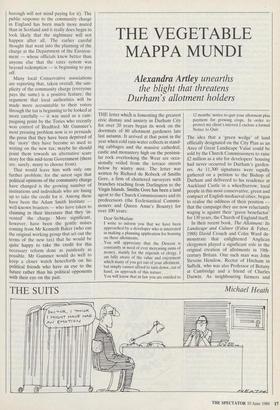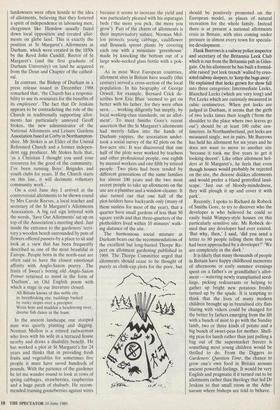THE VEGETABLE MAPPA MUNDI
Alexandra Artley unearths the blight that threatens Durham's allotment holders
THE letter which is fomenting the greatest civic dismay and anxiety in Durham City for over 20 years began its work on the doormats of 80 allotment gardeners late last autumn. It arrived at that point in the year when cold rain-water collects in stand- ing cabbages and the massive cathedral, castle and monastery high on the peninsu- lar rock overlooking the Wear are occa- sionally veiled from the terrace streets below by wintry mist. The letter was written by Richard de Robeck of Smiths Gore, a firm of chartered surveyors with branches reaching from Darlington to the Virgin Islands. Smiths Gore has been a land agent to the Church Commissioners and its predecessors (the Ecclesiastical Commis- sioners and Queen Anne's Bounty) for over 100 years:
Dear Sir/Madam I write to inform you that we have been approached by a developer who is interested in making a planning application for housing on these allotments.
You will appreciate that the Diocese is constantly in need of ever increasing sums of money, mainly for the stipends of clergy. I am fully aware of the value and enjoyment which many of you get out of your allotment, but simply cannot afford to turn down, out of hand, an approach of this nature. . . .
You will know that in law you are entitled to 12 months' notice to quit your allotment plus payment for growing crops. In order to protect my client's interest I enclose a formal Notice to Quit.
The idea that a 'green wedge' of land officially designated on the City Plan as an Area of Great Landscape Value could be sold by the Church Commissioners to raise £2 million as a site for developers' housing had never occurred to Durham's garden- ers. As 11,300 signatures were rapidly gathered on a petition to the Bishop of Durham and delivered to his residence at Auckland Castle in a wheelbarrow, local people in this most conservative, green and compact of English mediaeval cities, began to realise the oddness of their position that the campaign they are now reluctantly waging is against their 'green benefactor' for 130 years, the Church of England itself.
In their recent book, The Allotment: Its Landscape and Culture (Faber & Faber, 1988) David Crouch and Colin Ward de- monstrate that enlightened Anglican clergymen played a significant role in the original creation of allotments in 19th- century Britain. One such man was John Stevens Henslow, Rector of Hitcham in Suffolk, who was also Professor of Botany at Cambridge and a friend of Charles Darwin. As neighbouring farmers and landowners were often hostile to the idea of allotments, believing that they fostered a spirit of independence in labouring men, clergymen like Henslow usually faced down local opposition and created allot- ments on glebe land. This is exactly the position at St Margaret's Allotments in Durham, which were created in the 1850s by the Revd John Cundill, Rector of St Margaret's (and the first graduate of Durham University) on land he acquired from the Dean and Chapter of the cathed- ral.
In contrast, the Bishop of Durham in a press release issued in December 1988 remarked that, 'the Church has a responsi- bility to use its resources for the benefits of its employees'. The fact that Dr Jenkins appears to be contradicting the role of the Church in traditionally supporting allot- ments has particularly annoyed Geoff Stokes, the new administrator of the National Allotments and Leisure Gardens Association based at Corby in Northampton- shire. Mr Stokes is an Elder of the United Reformed Church and a former indepen- dent egg producer. Mr Stokes feels that, 'as a Christian I thought you used your resources for the good of the community. I've been running Boys' Brigades and youth clubs for years. If the Church starts on this line, it will decimate voluntary community work.'
On a cool June day I arrived at the controversial allotments to be shown round by Mrs Carole Reeves, a local teacher and secretary of the St Margaret's Allotments Association. A big red sign lettered with the words, 'Save Our Allotments' sat up on top of the Association's meeting shed. Just inside the entrance to the gardeners' terri- tory a wooden bench surrounded by pots of flowers offered passers-by a place to sit and look at a view that has been frequently described as one of the most beautiful in Europe. People born in the north-east are often said to have the closest emotional affinity with Anglo-Saxon poetry. The fruits of Sweet's boring old Anglo-Saxon Primer returned to mind in the form of 'Durham', an Old English poem with which a stage in our literature closed:
All Britain knows of this noble city its breathtaking site: buildings backed by rocky slopes over a precipice.
Weirs hem and madden a headstrong river, diverse fish dance in the foam.
In the ancient landscape one stooped man was quietly planting and digging. Norman Mollon is a retired railwayman who lives with his wife in a terraced house nearby and draws a disability benefit. He has worked a plot at St Margaret's for 24 years and thinks that in providing fresh fruits and vegetables for sometimes five people it must have saved hundreds of pounds. With the patience of the gardener he let me wander round to look at rows of spring cabbages, strawberries, raspberries and a huge patch of rhubarb. He recom- mended training gooseberries against wires because it seems to increase the yield and was particularly pleased with his asparagus beds ('the more you pick, the more you grow'). Part of the charm of allotments is their improvisatory nature. Norman Mol- lon protects young cabbage, cauliflower and Brussels sprout plants by covering each one with a miniature 'greenhouse' made by knocking the bottom out of a large wide-necked glass bottle with a pok- er.
As in most West European countries, allotment sites in Britain have usually (this century) served a cross-section of the local population. In his biography of George Orwell, for example, Bernard Crick de- scribes how Eric Blair 'seemed to get on better with his father, for they were often seen. . . working diligently but ineptly, by local working-class standards, on an allot- ment'. To meet Smiths Gore's recent assertion that the St Margaret's allotments had merely fallen into the hands of Durham yuppies, the association under- took a social survey of the 82 plots on the five-acre site. It was discovered that one half of the plots were worked by teachers and other professional people, one eighth by manual workers and one fifth by retired people. Two plots had been tended by different generations of the same families for almost 100 years and the two most recent people to take up allotments on the site are a plumber and a window-cleaner. It also turned out that one half of the plot-holders have backyards only (many of them sunless for most of the year), that a quarter have small gardens of less than 50 square yards and that three-quarters of the plotholders lived within 10 minutes' walk- ing distance of the site.
The harmonious social mixture at Durham bears out the recommendations of the excellent but long-buried Thorpe Re- port on allotment gardening published in 1969. The Thorpe Committee urged that allotments should cease to be thought of purely as cloth-cap plots for the poor, but should be positively promoted on the European model, as places of natural recreation for the whole family. Instead there is at present a national allotments crisis in Britain, with sites coming under pressure in almost every town for specula- ive development.
Hank Burrows is a railway police inspector and secretary of the Britannia Leek Club which is run from the Britannia pub in Giles- gate. On his allotment he has built a formid- able raised 'pot leek trench' walled by creo- soted railway sleepers, to 'keep the bugs away'. He explained that leeks grown for show fall into three categories: Intermediate Leeks, Blanched Leeks (which are very long) and Pot Leeks which are curiously measured in cubic centimetres. When pot leeks are judged in Durham, it seems that the girth of two leeks times their length ('from the shoulder to the place where two leaves go out') should be at least 100 cubic cen- timetres. In Northumberland, pot leeks are measured singly, not in pairs. Mr Burrows has held his allotment for six years and he does not want to move to another site 'because it took me five years to get it looking decent'. Like other allotment hol- ders at St Margaret's, he feels that even though houses would probably be rejected on the site, the diocese dislikes allotments and would prefer a bland gentrified land- scape. 'Just out of bloody-mindedness, they will plough it up and cover it with park'.
Recently, I spoke to Richard de Robeck of Smiths Gore, to try to discover who the developer is who believed he could so easily build Wimpey-style houses on this particularly sensitive site. Mr Robeck de- nied that any developer had ever existed. 'But why, then,' I said, 'did you send a letter to 80 people telling them that you had been approached by a developer?' We are completely in the dark.'
It is likely that many thousands of people in Britain have happy childhood memories of afternoons or early summer evenings spent on a father's or grandfather's allot- ment — watering newly transplanted seed- lings, picking redcurrants or helping to gather up bright new potatoes freshly turned up by the spade. It is tempting to think that the lives of many modern children brought up in brutalised city flats blaring with videos could be changed for the better by fathers emerging from the lift with a bunch of mint to go with the Sunday lamb, two or three kinds of potato and a big bunch of sweet-peas for mother. Shell- ing peas for lunch rather than just pulling a bag out of the supermarket freezer is something most young children would be thrilled to do. From the Diggers to Gardeners' Question Time, the chance to grow one's own food in Britain arouses ancient powerful feelings. It would be very English and pragmatic if it turned out to be allotments rather than theology that led Dr Jenkins to that small room in the Athe- naeum where bishops are told to behave.



























































 Previous page
Previous page